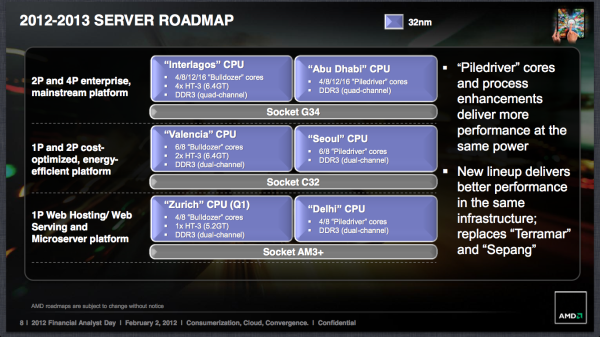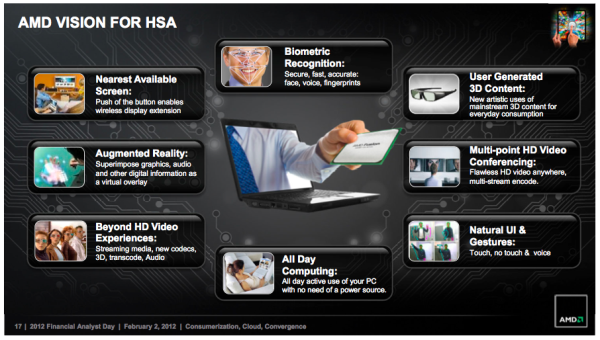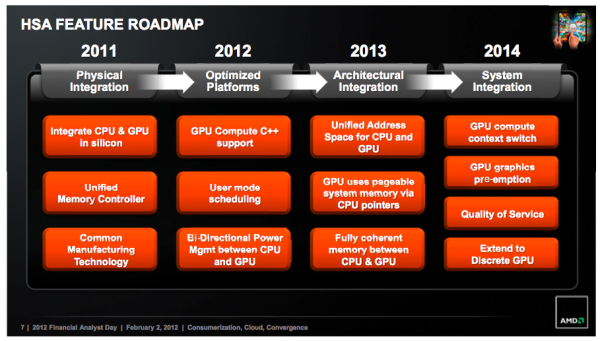Understanding AMD's Roadmap & New Direction
by Anand Lal Shimpi on February 2, 2012 6:16 PM EST- Posted in
- CPUs
- AMD
- Trade Shows
- AMD FAD 2012
The New Focus: Client Mobility
For years we had asked for lower power AMD mobile solutions. While we finally started seeing some progress over the past couple of years, AMD is now very committed to building mobile devices. Anything tablet sized or above is now AMD's target for client APUs.
AMD was always the high-end x86 CPU alternative to Intel in the PC space, now AMD is going to be the alternative in the ultra mobile space.
Servers & the High End Desktop
AMD's server roadmap for the next two years is a bit more conservative. We'll see Piledriver updates from top to bottom but there's no significant departure from the way things are done today. There are no plans for any new sockets in the near term, just using existing platforms to grow AMD's server marketshare without huge new investments.
As AMD's client strategy is predominantly built around APUs, the only high-end desktop parts we'll see from AMD are low-end server CPUs. Socket-AM3+ has a future for one more generation and we'll likely see other single-socket, high-end platforms for the desktop. The days of AMD chasing Intel for the high-end desktop market are done though. That war is officially over.
The Ace: HSA
AMD isn't going to have the fastest general purpose x86 CPUs on the market and it is no longer interested in pursuing that goal. It does promise to have much better on-die GPU performance than Intel. For users today that's primarily an advantage in 3D gaming. As more workloads shift to the GPU however, AMD could have a significant advantage here. The problem is that seamlessly scheduling client workloads across CPUs and GPUs just hasn't happened, the two islands of compute horsepower have remained discrete - even on the new wave of integrated APUs.
AMD's Heterogenous Systems Architecture (HSA) plans to change that. AMD wants to see the creation of a virtual ISA that will be the backbone of a software layer that can schedule application workloads on any combination of underlying CPU/GPU hardware, regardless of the ISA of the hardware. If you have a workload that's best run on big, general purpose x86 cores, that's where it will run. If a task is better designed for highly parallel GPUs cores, it'll run there. And presumably if you had an ARM core somewhere underneath and the workload would run better on it, you'd be covered as well.
AMD plans on delivering an HSA enabled GPU family by 2014, with today's Graphics Core Next GPUs being an intermediary step that already fill a number of these goals. These HSA GPUs would be able to share the same memory space as CPUs and work seamlessly as coprocessors. Granted AMD doesn't have the best track record of quickly moving the industry with things like HSA (although AMD64 did work out quite well), so we'll have to wait and see how all of this plays out.
If AMD can get broad industry support for HSA then its APUs become much more attractive. The overall performance of AMD solutions would then become more compelling as they'd take both CPU and GPU architectures into account, again assuming the workloads require both.













84 Comments
View All Comments
jabber - Monday, February 6, 2012 - link
Once again...if you are spending more than $10 you do your homework to check it will do the job you want it for.That's just basic common sense.
I guess you found that microwave oven you bought to clean the dishes didn't work out so well?
I bet if you looked up on certain IT forums you would have found plenty of folks who also didn't do their homework and also were struggling with AMD/Blackmagic.
Really in this day and age there isn't an excuse for it.
wifiwolf - Friday, February 3, 2012 - link
That would be as bad as if I bought a i5 2400 and a Nvidia 560 cardbut really wanted run render a lot (which seems you want to anyway) and use 4 monitors at the same time. In that case your current build would be best.
Let's just say you can't have it all without paying twice as much.
Marburg U - Friday, February 3, 2012 - link
Do you really think AMD can compete with designers as such as samsung\qualcom\TI\Boradcom in the ARM universe? Preposterous.For sure they won't pursue the SoC market... they haven't got any single IP which may be of some use in the SoC niche. Nvidia and Intel, for example, have just spent billions in aquisitions of wireless solutions. AMD have no money to spend on anything.
High end desktop\workstation\server... they will never be able to compete with intel.
AMD have only 2 proficiencies: 1) ATI and 2) an x86 license. it's quite clear that the only thing they can do is low cost APUs for consumer personal computers and GPUs.
BitJunkie - Friday, February 3, 2012 - link
I think you are missing the point. There is a big difference between the technology IN the product they are delivering and the WAY they end up at that product.The problem with most tech companies is that they get stuck on the technology and don't land a reliable way of delivering a product.
I'm not going to put a single penny in AMD until I can see the following:
1) They have a tight spec and set of objectives for each product and iteration.
2) They set up a proper matrix organisation with competent technical and commercial managers and execute each product in a safe and reliable way.
3) They set up a process of feeding back lessons learned from one project cycle to the next and implement a reliable continuous improvement programme
4) They start USING tech as a way of delivering their products, not as a centrepiece
A silicon fabrication process node is not a product, the product is the design, and the logic included in it which just so happens to be delivered on a process.
If they get that right, then they will be able to pick their technology and their process and be able to excel in any space.
Is it really that hard to see?
Yahma - Friday, February 3, 2012 - link
Now that competition in the enthusiast market is effectively dead, Intel has no reason to continue to innovate at the high end, let alone lower prices.We will go back to the days of the 386/486 when Intel ruled, and prices stayed high, while there were little improvements at the top end.
Its already starting to happen. Ivy Bridge is supposedly only a few % faster on the CPU side than its predecessor Sandy Bridge. Ivy Bridge is likely to be the last iteration on the high end in a long time. Haskell will probably be delayed/cancelled or neutered. Prices on anything faster than an Intel 2500k will be insane!
Thats what no competition brings.
Impulses - Friday, February 3, 2012 - link
Umm, IB wasn't supposed to be significantly faster than SB, just more efficient... Look up Intel's tick tock strategy. They're at the same pace they've been at for a few years now. If Intel stops innovating on the high end they just risk AMD catching up and they cannibalize their mobile sales unto which every new design trickles down... So that's not gonna happen. They could squeeze the desktop market and raise prices as they keep bringing out new designs, but they'd be squeezing a shrinking market dry for short term gain instead of using it as a proving grounds for mobile.seapeople - Saturday, February 4, 2012 - link
Intel's competitor in the desktop/laptop space hasn't been AMD for a while now, it's been the threat of smartphones/tablets or other small, low power devices. Intel has acknowledged this with their ultrabook push, and the logical course of action is to decrease the power consumption of their top line processors rather than increase performance.Think about it, if Ivy Bridge can perform the same as Sandy Bridge while using 25% less power, then the 6 hour battery life on that shiny ultrabook becomes closer to 8 hours, OR the battery size is reduced, the ultrabook still has 6 hours of battery life, but instead weighs 1.8 lbs instead of 2.0 lbs. Those are tangible product benefits that will make people more likely to buy Intel in today's world, whereas if Ivy Bridge instead kept the same power envelope and upped performance by 25% then you'd have the same ultrabook that's just 25% faster and nobody would care because it's already light years faster than an Ipad anyway.
I predict in 5 years the newest Intel top-end processor will only be 10-20% faster than Sandy Bridge but will use one-third to one-half the power.
tipoo - Monday, February 6, 2012 - link
"I predict in 5 years the newest Intel top-end processor will only be 10-20% faster than Sandy Bridge but will use one-third to one-half the power."Err, no. I'd bet dollars to donuts their next "tock" will beat that 10-20% already. Just because power consumption is going down doesn't mean they can't improve performance too, we have more than enough proof of that. 5 years is a lifetime in the processor industry, 5 years ago we had Core Solo and Core Duo and were just transitioning away from the Pentiums.
name99 - Friday, February 3, 2012 - link
"AMD's Heterogenous Systems Architecture (HSA) plans to change that. AMD wants to see the creation of a virtual ISA that will be the backbone of a software layer that can schedule application workloads on any combination of underlying CPU/GPU hardware, regardless of the ISA of the hardware."Wasn't this program called Java 20 years ago? How did that turn out?
Oh, right, because it now also targets GPUs, this time it's going to be different.
Good luck guys, but I can't say I'm optimistic about your chances.
arjuna1 - Friday, February 3, 2012 - link
Ah crap, meant "Kaveri", not Vishera.